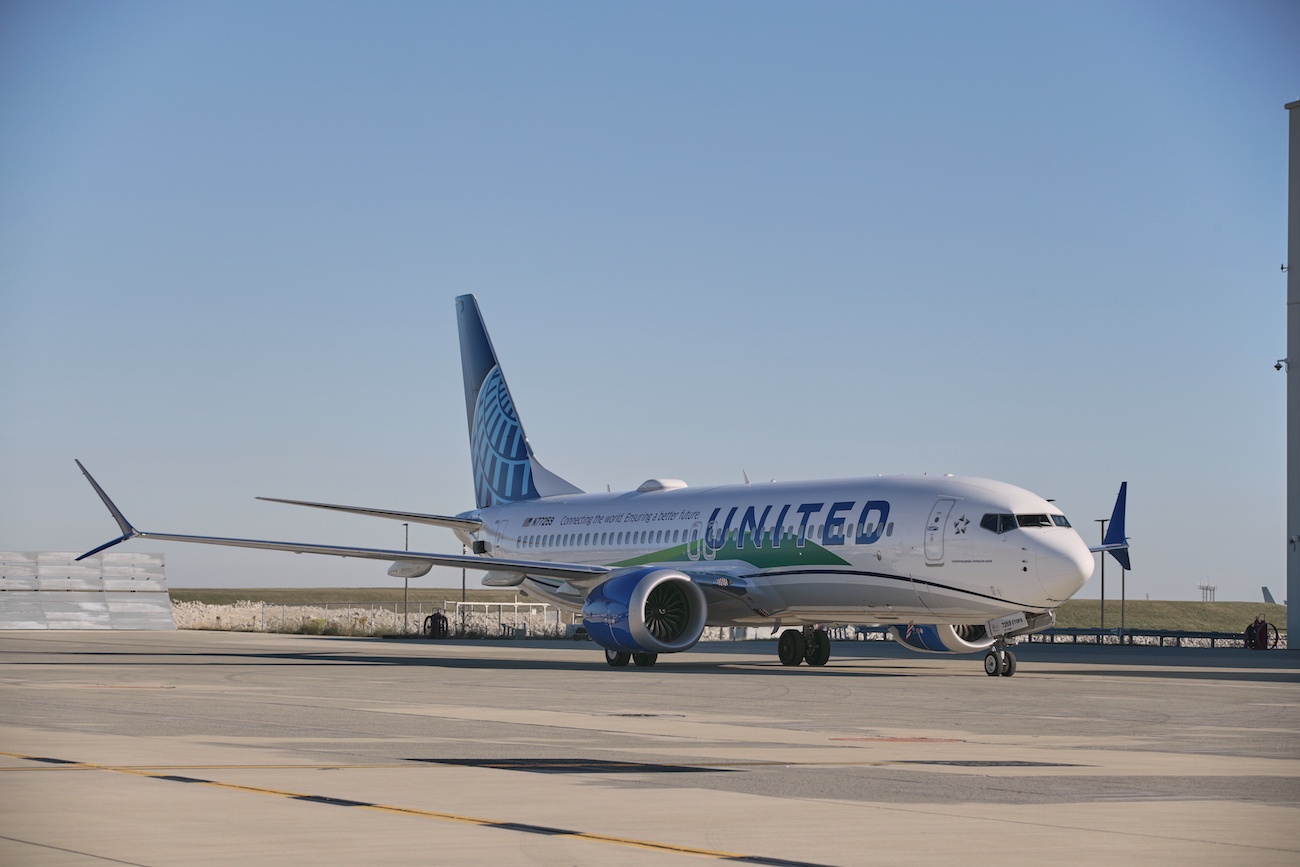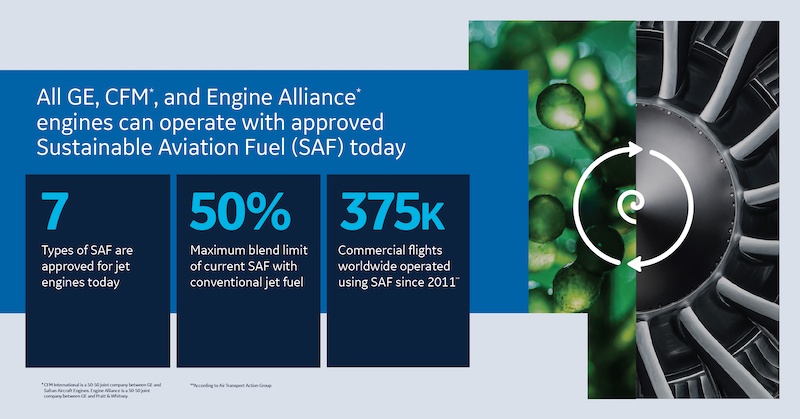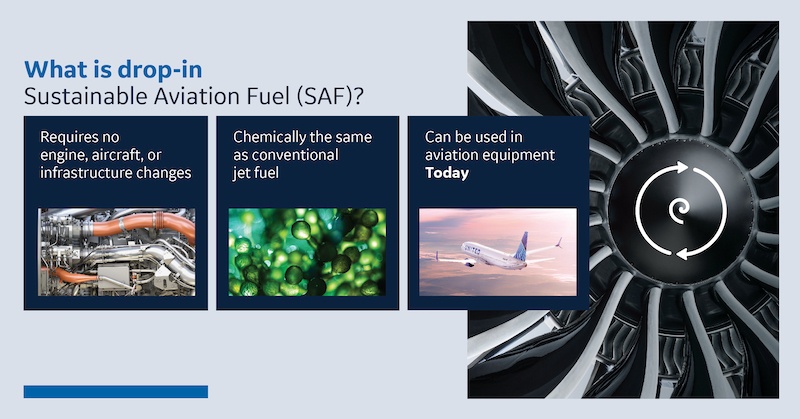United flies world’s first passenger flight on fully sustainable fuel on one engine
“Today’s SAF flight is not only a significant milestone for efforts to decarbonise our industry but when combined with the surge in industry commitments to produce and purchase alternative fuels, we are demonstrating the scalable and impactful way companies can join together and play a role in addressing the biggest challenge of our lifetimes,” said United CEO Scott Kirby, who was on the DC flight.
 |
| United’s flight was a demonstration of how drop-in sustainable aviation fuel can be used with no modifications needed to the plane or infrastructure. Photo: United |
Another person on board was GE Aviation’s CEO, John Slattery. The jet used a pair of LEAP-1B engines developed by CFM International, a 50-50 joint company between GE and Safran Aircraft Engines. GE has also been researching the use of SAF in its engines. Recent flights operated by Etihad Airways and British Airways used a fuel mix containing SAF, and GE Aviation is also working with Emirates on plans to test 100 percent SAF in 2022.
Currently, international standards following the process developed by ASTM International (which develops technical standards) permit airlines to use a maximum of 50 per cent SAF in commercial flights. So on this demonstration flight, United operated one of the plane’s two engines on 100 per cent conventional jet fuel and the other one on 100 per cent SAF – about 500 gallons in each engine.
 |
The SAF used by the jet was “drop-in” ready, meaning it is interchangeable with conventional Jet A and Jet A-1 fuel and requires no modifications to engines or airframes. This also makes it compatible with the existing commercial fleet and the existing fuel distribution and storage infrastructure.
“These molecules don’t know where they come from,” says Gurhan Andac, GE Aviation’s engineering leader for aviation fuels and additives, about the difference – or the lack thereof – between SAF and conventional jet fuel. Andac, who was also on board the United flight, has played an important role in researching biofuels and synthetic fuels for engines and promoting their use. He also chairs an international task force to develop standardised industry specifications supporting adoption of 100 per cent SAF.
GE Aviation’s SAF testing includes several industry-first flight tests: the first SAF commercial demonstration flight (2008), the first SAF transatlantic flight of a large freight commercial airplane (2011), the first 100 per cent SAF military jet flight (2016) and, earlier this year, the first use of power-to-liquid, in which renewable electricity is used to split water into hydrogen and oxygen, then the resulting H2 is used with captured CO2 to synthesise liquid hydrocarbon fuel.
 |
Besides CFM, United partnered on the flight with Boeing, Virent – a subsidiary of Marathon whose technology enables 100 per cent drop-in SAF – and World Energy, the world’s first and North America’s only commercial SAF producer.
United says it has made the largest commitment of any airline to the transition toward SAF. Last spring it launched the Eco-Skies Alliance programme, in which a list of 29 corporate partners and counting have collectively contributed toward the purchase of approximately 5.7 million gallons of SAF this year alone. This is enough SAF to eliminate approximately 53,000 metric tonnes of greenhouse gas emissions, or enough to fly passengers over 372 million miles.
Sustainable aviation fuel can be made from any of 60 different feedstocks – among them plant oils, algae, greases, fats, waste streams, alcohols, sugars, captured CO2, and other alternative feedstock sources and processes. The Department of Energy estimates that the US alone has the resources to produce 50-60 billion gallons of SAF per year. For context, commercial airlines will use about 57 billion gallons of fuel by the end of 2021, down from a peak of 95 billion gallons in 2019, according to Statista. By switching from petroleum to SAF – when you take into consideration the entire life cycle of the fuel – the aviation industry could reduce its carbon contribution from fuel by up to 80 per cent, according to Air Transport Action Group and the International Air Transport Association.
 |
However, so far, only a fraction of 1 per cent of the fuel consumed in aviation is SAF. To spur more investment in SAF and create more supply, demand must first grow, which is why United hopes the flight will set an example for others to follow.
“Drop-in SAF is something our industry can adopt now to begin making inroads on our commitment to be net-zero carbon emissions by 2050,” says Gaël Méheust, president and CEO of CFM International. “Along with our parent companies, GE Aviation and Safran Aircraft Engines, we applaud United for taking this bold initiative and look forward to even greater cooperation in the future.”
What the stars mean:
★ Poor ★ ★ Promising ★★★ Good ★★★★ Very good ★★★★★ Exceptional
 Tag:
Tag:
Related Contents
Latest News
More News
- Addressing Vietnam's energy challenges with aeroderivative gas turbines (February 28, 2023 | 09:33)
- How to sprint ahead in 2023’s worldwide energy priorities (February 08, 2023 | 13:55)
- Boosting Vietnam's grid stability through gas turbine technology (November 22, 2022 | 20:02)
- Healthcare trio collaborates to provide thousands of free breast scans (October 27, 2022 | 17:19)
- GE Healthcare's vision for AI-backed radiology (September 29, 2022 | 11:53)
- GE brand trio to shape the future of key industries (July 19, 2022 | 15:35)
- GE unveiling brand names and defining future (July 19, 2022 | 15:16)
- GE: the shortest route towards sustainability (July 18, 2022 | 08:00)
- Be proactive in an uncertain world (May 20, 2022 | 11:40)
- GE secures first 9HA combined cycle power plant order in Vietnam (May 16, 2022 | 17:06)























 Mobile Version
Mobile Version